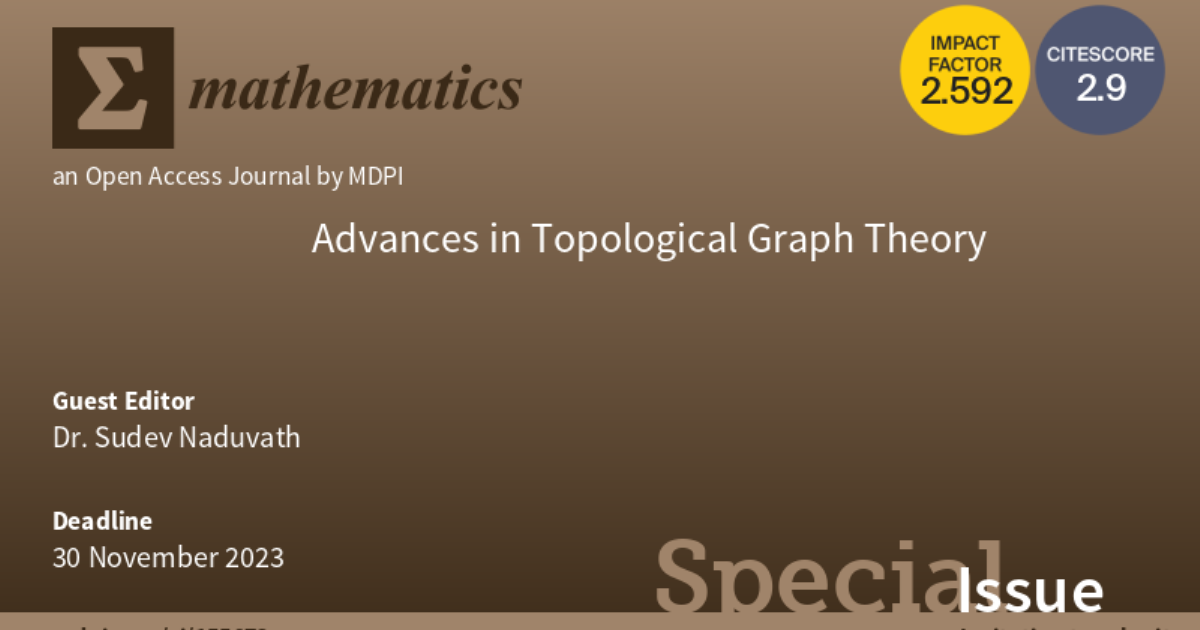Advances in Topological Graph Theory
A special issue of Mathematics (ISSN 2227-7390). This special issue belongs to the section "Algebra, Geometry and Topology".
Deadline for manuscript submissions: closed (30 November 2023) | Viewed by 8097

Special Issue Editor
Special Issue Information
Dear colleagues,
Topological graph theory is a branch of graph theory that deals with the geometric aspects and challenges related to graphs and graphs models. Topological graph theory is a promising area of research because of its wide range of applications. In any case, it is clear that the field of graph theory (or more specifically, topological graph theory) is endlessly fascinating. It crosses many disciplines, including combinatorics, geometry, design theory and low-dimensional topology, and it is filled with a wide range of problems, ranging in sophistication from simple examples to the material for elaborate research projects.
The use of topological concepts to investigate various aspects of graph theory, and vice versa, is a productive field of research. Problems in topological graph theory are largely indebted to various other topics in mathematics, such as abstract algebra, algebraic graph theory, algebraic topology and enumerative combinatorics. A fantastic place to begin one’s mathematical adventures, and a fantastic place to remain, of course, is topological graph theory. It is pervaded by the extremely seductive and evocative quality of the visualisability of many of its claims and results, as well as by a certain magic vis à vis inductive methods.
Despite being a promising area of research, topological graph theory is a less-explored field when compared to other areas of graph theory, both in specific topics and more generally in mathematics. The purpose of this Special Issue is to advance the literature by introducing high-calibre research, and to increase the appeal and popularity of the subject matter.
Potential topics include, but are not limited to, the following:
- Graph embeddings;
- Planar graphs;
- Duality;
- Topological combinatorics;
- Crossing numbers;
- Symmetric maps;
- Voltage graphs;
- Graph constructions;
- Surfaces and imbeddings;
- Genus;
- Topological indices of graphs;
- Chemical applications of graph indices;
- Mathematical properties of graph indices;
- Graph spectra;
- Graph energy;
- Algebraic graph theory;
- Chromatic graph theory.
Dr. Sudev Naduvath
Guest Editor
Manuscript Submission Information
Manuscripts should be submitted online at www.mdpi.com by registering and logging in to this website. Once you are registered, click here to go to the submission form. Manuscripts can be submitted until the deadline. All submissions that pass pre-check are peer-reviewed. Accepted papers will be published continuously in the journal (as soon as accepted) and will be listed together on the special issue website. Research articles, review articles as well as short communications are invited. For planned papers, a title and short abstract (about 100 words) can be sent to the Editorial Office for announcement on this website.
Submitted manuscripts should not have been published previously, nor be under consideration for publication elsewhere (except conference proceedings papers). All manuscripts are thoroughly refereed through a single-blind peer-review process. A guide for authors and other relevant information for submission of manuscripts is available on the Instructions for Authors page. Mathematics is an international peer-reviewed open access semimonthly journal published by MDPI.
Please visit the Instructions for Authors page before submitting a manuscript. The Article Processing Charge (APC) for publication in this open access journal is 2600 CHF (Swiss Francs). Submitted papers should be well formatted and use good English. Authors may use MDPI's English editing service prior to publication or during author revisions.
Keywords
- algebra
- topology
- geometry
- graphs
- combinatorics
- algebraic graph theory
- topological graph theory
- discrete mathematics
Benefits of Publishing in a Special Issue
- Ease of navigation: Grouping papers by topic helps scholars navigate broad scope journals more efficiently.
- Greater discoverability: Special Issues support the reach and impact of scientific research. Articles in Special Issues are more discoverable and cited more frequently.
- Expansion of research network: Special Issues facilitate connections among authors, fostering scientific collaborations.
- External promotion: Articles in Special Issues are often promoted through the journal's social media, increasing their visibility.
- e-Book format: Special Issues with more than 10 articles can be published as dedicated e-books, ensuring wide and rapid dissemination.
Further information on MDPI's Special Issue polices can be found here.





